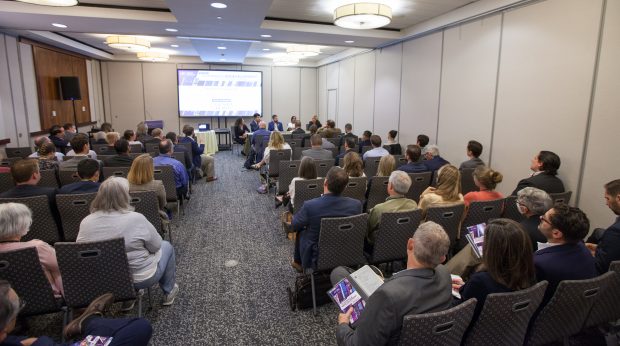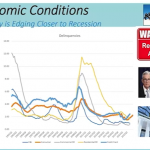New Jersey Future Blog
The State of New Jersey’s Housing Market: We Need More
July 11th, 2022 by Tim Evans

Breakout session “The State of Housing in New Jersey” during the New Jersey Future and APA-NJ New Jersey Planning and Redevelopment Conference 2022 at the Hyatt Regency, New Brunswick on June 16, 2022. Photo Credit: Keith Muccilli
New Jersey is facing an acute housing shortage. Nationally, we are millions of housing units short of meeting demand, and the situation is proportionally worse in New Jersey. That was the big-picture message delivered by Debra Tantleff, founding principal of Tantum Real Estate, to kick off the session on The State of Housing in New Jersey at the 2022 NJ Planning and Redevelopment Conference, hosted jointly by New Jersey Future and the New Jersey chapter of the American Planning Association. Demand for housing in New Jersey is far exceeding supply, especially middle-income housing. Failure to produce enough housing, both in terms of the types of housing that potential residents are looking for, and in the kinds of places where today’s homebuyers and renters want to live, puts upward pressure on prices and incentivizes people to look elsewhere.
Adam Gordon, executive director of the Fair Share Housing Center, said that housing unit growth did not keep pace with population growth in the 2010s, particularly because of low production of multi-family housing in the first half of the decade. The slowdown happened in the wake of the 2011 dissolution of the Council on Affordable Housing (COAH), the state agency that had been in charge of overseeing municipal compliance with the Mount Laurel Supreme Court decisions, which require municipalities to allow the creation of housing for low- and moderate-income households. Many towns have chosen to satisfy their Mount Laurel obligations via mixed-income, multi-family projects that include a lower-income component along with market-rate units. The interim between the demise of COAH and the subsequently instituted system of enforcement by lower courts created temporary uncertainty about the determination of municipalities’ obligations, leading to a temporary dropoff in multi-family construction in general.
The lull in multi-family housing production illustrates the extent to which the state implicitly relies on Mount Laurel requirements to provide not just housing for low- and moderate-income households but much of the state’s new middle-income housing as well. Without Mount Laurel, it is not clear how much multi-family housing the state would be producing at all—and it might not be very much, if the rest of the New York metropolitan area is any indication. In the 2010s, the counties of northern New Jersey produced vastly more new housing units per capita than did Long Island, the Hudson Valley, or southwestern Connecticut. This raises questions as to whether relying on the Mount Laurel mechanism is really a sustainable long-term solution for ensuring that the middle class can continue to afford to live in New Jersey.
Fortunately, not all towns take a reactive approach to producing middle-class housing. Scotch Plains is an example of a suburban municipality proactively trying to adapt to evolving market demand for compact, walkable neighborhoods. Thomas Strowe, director of Redevelopment for the Township, spoke about the Township’s recent redevelopment efforts, which are focused on invigorating its small downtown and turning it into more of a mixed-use destination. The Township seeks to make downtown living available to a wider range of households via mixed-income projects that will be enabled by downtown overlay zones and density bonuses. The bonus requires a 20% inclusionary component (that is, 20% of the units must be affordable to low- and moderate-income households), along with public open space and other amenities, thus allowing the Township to address its Mount Laurel obligations while pursuing a broader redevelopment goal. Multiple developers are seeking to take advantage of the bonuses, another sign of the pent-up demand for in-town living.

Breakout session “The State of Housing in New Jersey” during the New Jersey Future and APA-NJ New Jersey Planning and Redevelopment Conference 2022 at the Hyatt Regency, New Brunswick on June 16, 2022. Photo Credit: Keith Muccilli
Meanwhile, on the other end of the spectrum are older, more urbanized municipalities where, until recently, the main problem was not lack of supply but lack of demand for market-rate housing. Tiffany Harris-Delaney, the Director of Policy, Planning, and Development for the City of East Orange, talked about the flurry of recent development projects happening in her city, particularly near its two NJ Transit commuter rail stations. Harris-Delaney pointed to East Orange’s diverse housing stock (84% of its housing units are something other than single-family detached) as a reason the city has long been affordable to a wide range of household incomes, and city leaders would like to keep it that way.
In the face of surging demand for walkable and transit-accessible neighborhoods, East Orange is more vulnerable to the displacement of existing residents than most places, with renters comprising 76% of its households, so together, the City and developers have worked to ensure that new projects incorporate both market-rate and lower-income units, in order to mitigate upward pressure on prices. Gordon said the Fair Share Housing Center has been working with many older urban centers facing similar pressures, encouraging them to adopt inclusionary zoning ordinances–that is, requirements that new residential developments designate a certain percentage of their units for occupancy by low- and moderate-income households–as a way of getting ahead of the displacement issue as market demand returns to cities after decades of absence.
Panelists agreed that cooperation between the public and private sectors makes housing production easier, especially for inclusionary projects. Debra Urban, chief of Multifamily Programs at the New Jersey Housing and Mortgage Finance Agency and the session’s moderator, said that her agency has multiple programs that are designed to help close financing gaps for inclusionary projects, as well as the well-known Low Income Housing Tax Credit program, which has been responsible for facilitating affordable housing projects in a wide variety of places in New Jersey. Tantleff mentioned the importance of payments in lieu of taxes (PILOTs) and redevelopment area bonds (RABs)—both of which require municipal participation—for making projects cheaper and simpler to finance. She also advised towns to talk to developers in advance about the feasibility of different kinds of housing in redevelopment plans. Strowe pointed out that Scotch Plains has adopted a redevelopment plan for its publicly-owned properties and is soliciting proposals. Tantleff and Gordon each praised both Scotch Plains and East Orange for thinking ahead about the kinds of development they want to see and working with developers to make it happen.
When asked whether the goals of affordable housing advocates and the goals of private developers will continue to coincide over the next 20 years, Tantleff said essentially yes. As Gordon explained, there is so much pent-up demand for housing that it will take a long time for supply to catch up, part of the reason that developers are still able to build for the top of the market in most places. If New Jersey wants to be able to continue to welcome or retain people of all income levels, it needs to both produce more multi-family housing at scale, and preserve existing affordable housing supply. This may involve considering statewide zoning reform, in addition to relying on the Mount Laurel system to incentivize the production of middle-income housing options, and it may mean that inclusionary zoning ordinances should become the rule rather than the exception, in order to avoid displacing existing residents. One way or another, New Jersey needs to find a way to break its housing supply logjam. As Gordon put it, “We shouldn’t need subsidies to produce a $500,000 house.”
Related Posts
Tags: Affordable housing, Development, downtowns, Housing, municipalities, neighborhoods, New Jersey planning and redevelopment conference, Population, Redevelopment, suburban, walkable neighborhoods
















